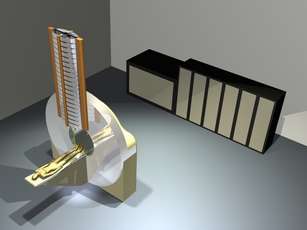|
|
|
| Oncology | |
Compact proton accelerator could revolutionise radiotherapy3 August 2007 The prospect of more widely available proton radiation therapy has moved closer with the development of a compact device called a dielectric wall accelerator (DWA). A prototype DWA is currently being built at Lawrence Livermore, Laboratory in the US. It can accelerate protons to up to 100 million electron volts in just a metre. A two-metre DWA could potentially supply protons of sufficiently high energy to treat all tumours, including those buried deep in the body, while fitting in a conventional radiation treatment room.
Thomas R. Mackie, a professor at the University of Wisconsin and co-founder of the radiation therapy company TomoTherapy, presented the new design at last month's annual meeting of the American Association of Physicists in Medicine in Minneapolis. Professor Mackie is part of a multidisciplinary team that includes his institutions as well as Lawrence Livermore National Laboratory and the University of California, Davis. Compared to the x-rays conventionally used in radiation therapy, protons are potentially more effective, as they can deposit more cell-killing energy in their tumour targets and less in surrounding healthy tissue. However, to kill tumours, the protons must be accelerated to sufficiently high energies, which currently must be achieved in large, expensive devices called cyclotrons or synchrocyclotrons that cost hundreds of millions of dollars and occupy a room the size of basketball courts. In addition to its smaller size, a DWA-based proton therapy system would have another benefit — it could vary both proton energy and proton-beam intensity, two variables that cannot both be adjusted at the same time in existing proton-treatment facilities. This capability could lead to "intensity-modulated proton therapy" (IMPT), the proton version of the x-ray-based intensity modulated radiation therapy (IMRT) technique which has become a popular method for delivering precise radiation doses to the parts of a tumour. Professor Mackie cautions that clinical trials of the system are at least five years away. But if the DWA approach proves feasible, protons may eventually represent a widespread, rather than limited, option for treating cancer.
|
